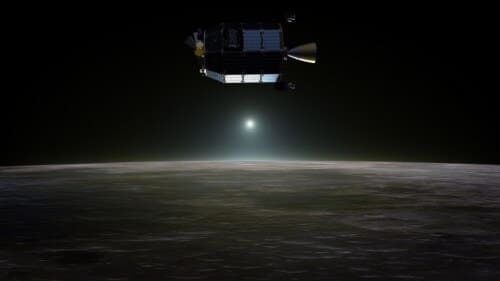According to NASA, this is a planned crash after it completed the 100 days allotted for the lunar dust research mission

Ground controllers at NASA's Ames Space Center in Mufty Field, California, confirmed that the Lunar Atmosphere and Dust Environment Explorer (LADEE) spacecraft crashed on the lunar surface as planned on Thursday, April 17 between 21:30 p.m. and 22:22 p.m. The west coast (ie Friday, 18/4 in the morning Israel time).
LADEE did not have enough fuel to maintain its orbit around the moon for a long time and to continue the scientific missions and therefore it was deliberately launched on a crash course. The orbit of the spacecraft was reduced following the final phase of the mission which required it to hover at a low altitude above the moon.
The engineers estimate that LADEE, which is the size of a refrigerator for selling drinks, disintegrated and most of its parts heated up to temperatures of several hundred degrees and may have even evaporated on the ground. The remains that remain buried are most likely in shallow craters.
"At the time of impact, LADEE was flying at a speed of approximately 5,700 km/h, three times the speed of a rifle bullet," said Eric Elpik, LADEE project manager at NASA's Ames Center. "There is nothing subtle about hitting these speeds - it's just a matter of chance whether LADEE created a local crater on a hillside or scattered debris across a flat area. It will be interesting to find out what shape LADEE created.
At the beginning of April, the flight controllers ordered the spacecraft to maneuver to a trajectory in the lower part of which would bring it to a distance of less than 2 km above the surface, much less than the flight altitude of civilian airplanes on Earth. This allowed scientists to collect unprecedented scientific measurements.
On April 11, LADEE performed the final maneuver to ensure a trajectory that would cause it to hit the far side of the Moon, which is not visible from Earth, and certainly far from any previous landing or crash site. LADEE also survived the April 15th total lunar eclipse. This demonstrates the spacecraft's ability to survive low temperatures with what little battery power it had left as the Moon crossed Earth's deep shadow.
In the coming months, the mission controllers will determine the exact location of the impact and together with the personnel of the LRO lunar orbiter mission will try to photograph the impact site. LRO launched in 2009 provided detailed data and images of the lunar surface.
"There is a bittersweet taste in receiving the final transmission from the LADEE spacecraft after spending years building it here at Ames, and then being in constant contact with it as it orbited the moon for the past few months," says Butler Hein, LADEE project manager at Ames.
Launched in 2013 from the New Wallops Launch Facility in Virginia, the spacecraft began orbiting the Moon on October 6, 2013 and data collection on November 10. The spacecraft entered a scientific orbit around the moon's equator on November 20, and in March 2014 its mission was extended following the success of the XNUMX-day phase for which it was designed.
LADEE also hosted NASA's first dedicated two-way communication system using a laser instead of radio waves. The Lunar Laser Communication Demonstration (LLCD) system made history when it used laser pulses to transmit data from a distance of 400 thousand kilometers - to Earth at a record speed of 622 megabits per second. In addition, an error-free upload rate of 20 Mbps was transmitted from the ground station in New Mexico to the laser communications terminal on board LADEE.
LADEE collected detailed data about the structure and composition of the moon's thin atmosphere. In addition, the scientists hope to use the data to answer an age-old question - is lunar dust, electrically charged by sunlight, responsible for the pre-dawn glow seen over the horizon during some of the Apollo missions?
"LADEE was a pioneering mission and achieved another initial achievement by successfully flying for over 100 days at very low altitudes," says John Salot, LADEE program manager at NASA Headquarters in Washington. "Although this is a risky decision, we already see evidence that the risk was worth it."
A thorough understanding of the properties of our nearest neighbor will help researchers understand the findings from other bodies in the solar system such as large asteroids, Mercury and the moons of the outer planets.
